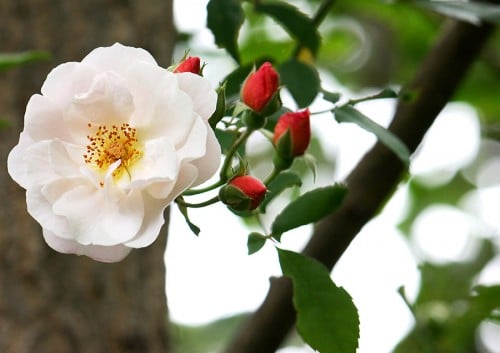
When I choose a new rose, I select a cultivar known to be resistant to blackspot disease and then integrate it with other perennials and shrubs. Growing many roses together in a traditional rose bed sets up a monoculture that invites disease — if one gets sick, there’s good opportunity for the pathogen to spread quickly to vulnerable neighbours.
Some of my favourites include ‘Etna’, a purple-red moss rose (named for the Sicilian volcano), and tall, bright pink ‘Therese Bugnet’ (a hybrid of Rosa rugosa and R. blanda, bred in Alberta) with raspberry canes. Both have a deep, fruity perfume and strong resistance to blackspot. ‘Blossomtime’, a pink climbing rose with darker reverse petal, grows through a Viburnum carlessii and ‘Clair Matin’, with frilled light pink petals and bright yellow stamens, grows up and into a ginkgo tree. I like to use taller woody plants as supports for climbers; it’s a natural look and easier than tying them to a trellis.
After their first feeding in May, I feed again in July in order to stimulate new wood for more flowers through the summer and early autumn. Feeding roses in August runs the risk of spurring tender growth that won’t mature before frost. Roses are eager eaters, requiring nutrient supplements to produce the numbers of blooms gardeners desire.
One year when I was looking through the garage, I found various suitable products still in fresh condition — a generous amount of alfalfa pellets, two bags of composted cow manure, half a bag of worm castings, two boxes of bonemeal and a bag of kelp meal. These are all organic materials with low nutrient analysis. I combined the cow and worm manures as the main fertilizer; they’re low in basic nutrients and won’t burn plant roots, and rich in beneficial enzymes and bacteria. I mixed in some alfalfa pellets for a gentle amount of nitrogen and, more importantly, for the naturally occurring hormone triacontanol (an alcohol ester compound that acts as a growth stimulant) it contains. I added bonemeal for a supply of slow-release phosphorus, and the kelp meal for potassium and plant hormones.
This may seem a cavalier method of combining nutrients without carefully measuring or considering the specific nutrient analysis, but that’s one of the benefits of working with simple organic materials. Three or four trowels of the mix went to each rose, scratched into the soil over the roots, and not worrying about overdosing plants with high amounts of nutrients. The added benefit is the full range of trace elements available in these materials, and the biological enzymes that activate soil organisms. Roses respond enthusiastically to organic foods, and they loved the meal I prepared for them!

Hello Joy (July 7)
Yes! Absolutely! Epsom salts (magnesium sulfate and sulphur) are wonderful for roses. Using half a cup twice a year per shrub will increase the canes and the flowers. Thanks for reminding me about this — I don’t keep it in the garage, but it’s in the basement and I’ll go get it out.– Judith
I love the “mix” to strengthen and gently feed the roses!
I also use the old method of half a cup of Epsom salts and find it does quite a remarkable job for keeping my roses strong and healthy : ) I have some leftover sheep manure that can be used again .. thanks for jogging my memory : )
Joy